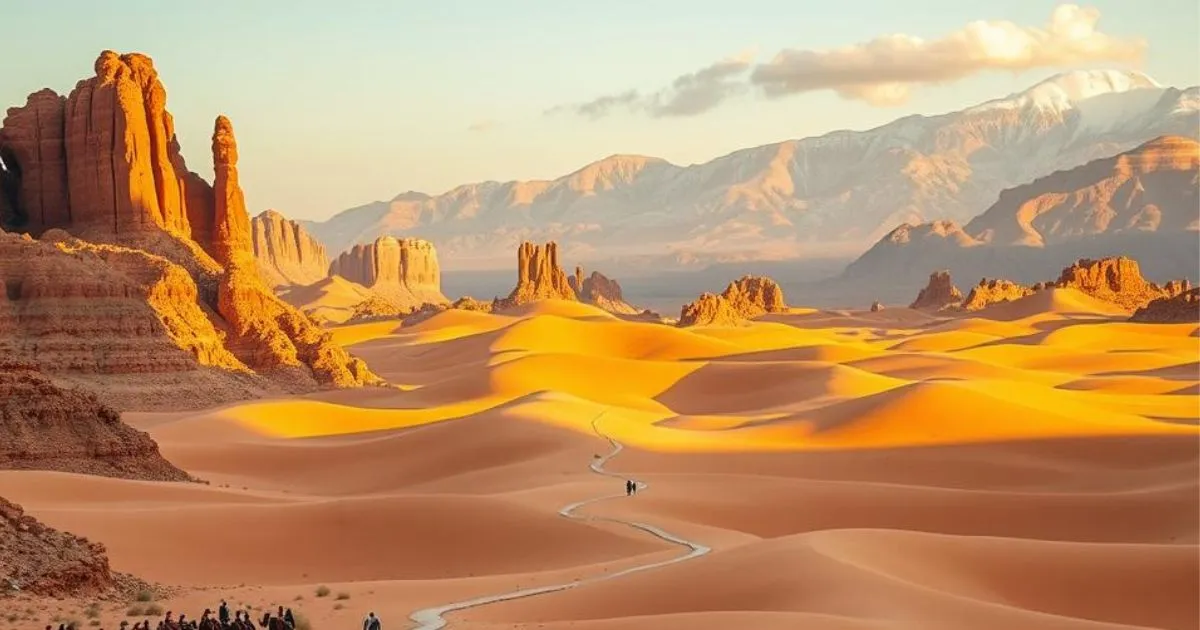Trips to Tabuk: Ancient Trade Routes and Natural Beauty
Table of Contents
Tabuk: A Journey Through Ancient Trade Routes and Natural Splendor
Tabuk, the northwestern gateway of Saudi Arabia, stands as a captivating region where the echoes of ancient civilizations meet breathtaking natural landscapes. Far from the well-trodden tourist paths, Tabuk offers a unique window into the history of Arabian trade and the raw, untamed beauty of the desert, mountains, and sea.
A Crossroads of Civilizations: Tabuk’s Historical Significance
Tabuk’s strategic location made it a vital nexus on ancient trade routes, most notably the Incense Road, which connected the sophisticated cultures of the southern Arabian Peninsula with the empires of Egypt, the Levant, and Mesopotamia.
Key Historical Landmarks:
- The Nabatean Legacy: Pre-dating their more famous city of Petra in Jordan, the Nabateans left their mark on Tabuk. Their expertise in water management and rock-cut architecture can be seen in various archaeological sites, telling the story of a civilization that mastered the art of desert living and commerce.
- Tabuk Castle: This historic fortress is a palimpsest of history, with origins believed to date back to the Nabatean era. It has been rebuilt and restored over centuries, including during the Islamic and Ottoman periods. It now serves as a museum, housing artifacts that chronicle the region’s long and storied past.
- The Hejaz Railway: The iconic, if now skeletal, remains of the Hejaz Railway stations stand as a testament to a more recent historical era. This ambitious Ottoman project, intended to connect Damascus to Medina, was a feat of engineering that further cemented Tabuk’s role as a crucial transit point.
- Ancient Petroglyphs: Scattered throughout the region, prehistoric rock carvings offer a glimpse into the lives, beliefs, and fauna of the area’s earliest inhabitants. These open-air galleries provide an invaluable record of human presence spanning millennia.
A Tapestry of Landscapes: Tabuk’s Natural Wonders
Beyond its historical treasures, Tabuk is defined by its dramatic and diverse geography, offering a haven for nature enthusiasts and adventurers.
Coastal Beauty: The Red Sea
The Red Sea coastline of Tabuk is renowned for its pristine condition. The crystal-clear waters and vibrant coral reefs, particularly near areas like the “Saudi Maldives,” are a paradise for snorkelers and divers, teeming with marine life.
Mountainous Majesty:
- Jabal Al-Lawz: Meaning “Mountain of Almonds,” Jabal Al-Lawz is one of the highest peaks in Saudi Arabia. Its striking appearance and the occasional dusting of snow in winter make it a prominent feature of the landscape, surrounded by local folklore and historical intrigue.
- The Hijaz Mountains: This mountain range runs parallel to the coast, offering spectacular vistas, challenging hiking trails, and a cooler climate. The rugged terrain is dotted with hidden valleys and ancient paths.
Desert and Valley Formations:
- Wadi Disah (Valley of Palm Trees): This breathtaking valley is a stunning contrast to the surrounding desert. Sheer sandstone cliffs tower over a lush floor filled with palm groves and freshwater springs, creating a spectacular oasis ideal for exploration.
- The Hisma Desert: A geological wonder, the Hisma Desert is characterized by its dramatic rock formations, sculpted by wind and sand over millions of years. The area’s unique, weathered landscapes are a photographer’s dream.
Cultural Heritage and Local Life
The cultural fabric of Tabuk is woven from its Bedouin traditions and its history as a trading hub. Visitors can experience this through:
- Traditional Souks: Local markets offer a sensory immersion, with the aroma of spices, the sight of handmade crafts, and the vibrant atmosphere of daily commerce.
- Regional Cuisine: The local cuisine reflects a heritage of simplicity and flavor, often featuring dates, wheat, lamb, and bread baked in traditional clay ovens.
Key Takeaways
- Tabuk is a region of profound historical significance, having served as a critical hub on ancient trade routes like the Incense Road.
- Its diverse landscapes encompass the pristine Red Sea coast, the majestic Hijaz Mountains, and stunning desert formations like Wadi Disah and the Hisma Desert.
- The area is home to important cultural heritage sites, including Tabuk Castle, Hejaz Railway stations, and ancient Nabatean and petroglyph sites.
- Together, these elements make Tabuk a unique destination for those interested in archaeology, history, geology, and outdoor adventure.

